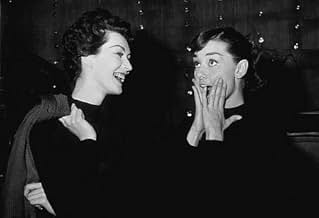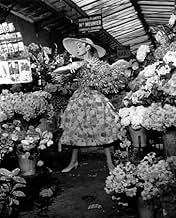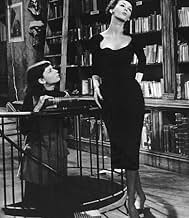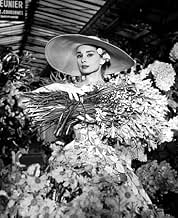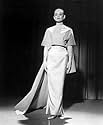NOTE IMDb
7,0/10
35 k
MA NOTE
Un défilé de mode improvisé dans une librairie entraîne une jeune libraire vers le monde de la mode.Un défilé de mode improvisé dans une librairie entraîne une jeune libraire vers le monde de la mode.Un défilé de mode improvisé dans une librairie entraîne une jeune libraire vers le monde de la mode.
- Réalisation
- Scénario
- Casting principal
- Nommé pour 4 Oscars
- 2 victoires et 10 nominations au total
Heather Ames
- Junior Editor
- (non crédité)
Fern Barry
- Southern Wife
- (non crédité)
Brandon Beach
- Fashion Show Guest
- (non crédité)
Paul Bisciglia
- Photographer
- (non crédité)
Avis à la une
As long as you do not take the premise or the characters or the plot too seriously, this is an enjoyable movie with an interesting pairing of Fred Astaire and Audrey Hepburn, plus an excellent supporting performance by Kay Thompson and some good-looking settings and scenery. The musical numbers are pleasant, if rather on the light side. Stanley Donen has the right touch in keeping things together without making the seams show too often.
Hepburn is cast in a somewhat unexpected role, as a drab intellectual store clerk who gets involved with Fred Astaire's (much older) photographer character. Audrey is so charming that's it's very difficult to think of her as a wallflower, and while Astaire is as energetic as ever, there are more than a couple of occasions on which the relationship doesn't really look believable, despite the best efforts of the two stars. The plot isn't supposed to be anything weighty anyway, so perhaps that's the price you have to pay for a rather different pairing.
Kay Thompson provides many of the best moments. Sometimes the satire of trendy philosophy comes off well, at other times it gets a little dull. Not to be forgotten are the colorful and interesting settings and backgrounds, which set off the story and music fairly well. It's sometimes a strange combination, but as lighter entertainment it all works well enough.
Hepburn is cast in a somewhat unexpected role, as a drab intellectual store clerk who gets involved with Fred Astaire's (much older) photographer character. Audrey is so charming that's it's very difficult to think of her as a wallflower, and while Astaire is as energetic as ever, there are more than a couple of occasions on which the relationship doesn't really look believable, despite the best efforts of the two stars. The plot isn't supposed to be anything weighty anyway, so perhaps that's the price you have to pay for a rather different pairing.
Kay Thompson provides many of the best moments. Sometimes the satire of trendy philosophy comes off well, at other times it gets a little dull. Not to be forgotten are the colorful and interesting settings and backgrounds, which set off the story and music fairly well. It's sometimes a strange combination, but as lighter entertainment it all works well enough.
You have Audrey Hepburn, you have Fred Astaire, you have Gershwin songs. Who needs a plot?
Okay, there was something of a plot, something about a Greenwich Village girl who wants to go to Paris, talk b.s. philosophy on the Left Bank, wear black clothes and no make-up. It reads like something out of one of Woody Allen's early stories - before he wrote it!
Audrey Hepburn never knew how to look bad nor act bad. But in this she looks light-years more beautiful as the proverbial Greenwich Village used-book-store Plain Jane than any Paris fashion model - then or now.
Okay, there was something of a plot, something about a Greenwich Village girl who wants to go to Paris, talk b.s. philosophy on the Left Bank, wear black clothes and no make-up. It reads like something out of one of Woody Allen's early stories - before he wrote it!
Audrey Hepburn never knew how to look bad nor act bad. But in this she looks light-years more beautiful as the proverbial Greenwich Village used-book-store Plain Jane than any Paris fashion model - then or now.
The first of two films released in 1957 in which Fred Astaire effectively bade farewell to the genre he had bestrode like a colossus for nearly a quarter of a century is the cinematic equivalent of gorging yourself on a box of chocolates without the calories.
The title photographs by Richard Avedon (on whom the character played by Astaire was based) establish the iconic fifties cool that never lets up for the rest of the film. Had they shot the whole thing in the studio, the Gershwin score, Technicolor, VistaVision and Edith Head creations worn by all the cast but Audrey Hepburn would already have induced pleasure overload. But producer Roger Edens also shipped the crew to Paris and whipped that into the brew.
It shows how spoiled they were in those days that it didn't collect a single Oscar.
The title photographs by Richard Avedon (on whom the character played by Astaire was based) establish the iconic fifties cool that never lets up for the rest of the film. Had they shot the whole thing in the studio, the Gershwin score, Technicolor, VistaVision and Edith Head creations worn by all the cast but Audrey Hepburn would already have induced pleasure overload. But producer Roger Edens also shipped the crew to Paris and whipped that into the brew.
It shows how spoiled they were in those days that it didn't collect a single Oscar.
The bookshop salesgirl Jo Stockton (Audrey Hepburn) is accidentally found by the photograph Dick Avery (Fred Astaire), who convinces the owner of the fashion magazine Quality, the powerful Maggie Prescott (Kay Thompson), that she could be the new model she wants for the magazine. Jo dreams on going to Paris to meet her guru, the philosopher Prof. Emile Flostre (Michel Auclair), but she cannot afford to pay for the travel; therefore she sees in the invitation, the chance to visit Paris. Once there, Dick falls in love for her.
"Funny Face" has a great cinematography, art direction, set decoration, costume design and most important, a charming and delightful Audrey Hepburn. Kay Thompson is also excellent. The problem is the silly screenplay that shows at least two great mistakes. The first one is the inconsistent and contradictory character Jo Stockton, presented as an intelligent and clever woman in the beginning, but later becoming absolutely shallow, acting like an irresponsible spoiled child. The second big mistake is Fred Astaire (58), thirty years old older than Audrey Hepburn (28), therefore more than twice her age, as her romantic pair. This great actor looks like her father, and there is no romantic chemistry between them. My vote is seven.
Title (Brazil): "Cinderela em Paris" ("Cinderella in Paris")
"Funny Face" has a great cinematography, art direction, set decoration, costume design and most important, a charming and delightful Audrey Hepburn. Kay Thompson is also excellent. The problem is the silly screenplay that shows at least two great mistakes. The first one is the inconsistent and contradictory character Jo Stockton, presented as an intelligent and clever woman in the beginning, but later becoming absolutely shallow, acting like an irresponsible spoiled child. The second big mistake is Fred Astaire (58), thirty years old older than Audrey Hepburn (28), therefore more than twice her age, as her romantic pair. This great actor looks like her father, and there is no romantic chemistry between them. My vote is seven.
Title (Brazil): "Cinderela em Paris" ("Cinderella in Paris")
Stanley Donen's "Funny Face" was one of the best musicals that came out of Paramount, a studio not known for that genre. The DVD format we watched recently seems to have been transferred with great care as the colors have a vibrant look, something that wasn't the case with the technique used during that era that made colors fade.
The film owes its appeal to Audrey Hepburn, an actress not known for being a singer, or a dancer, but who had enough charm to make the movie her own. The pairing with the great Fred Astaire pays off well because Mr. Astaire was always an actor who had enough chemistry with his leading ladies. Ms. Hepburn's costumes by Givenchy and the way she carries herself in them is one of the best assets about "Funny Face".
The other surprise of the movie is Kay Thompson, who plays the magazine editor Maggie Prescott. Ms. Thompson makes an excellent contribution to the film as the no nonsense woman who ruled what the fashions of the day should be as shown in the pages of the magazine.
The songs of George Gershwin are complimented by the original music composed for the musical by Roger Edens, Adolph Deutsch and Leonard Gershe. The great cinematography of Ray June shows Paris at its best. Thanks to Stanley Donen all the elements feel into place and we were left with this musical that will delight audiences forever.
The film owes its appeal to Audrey Hepburn, an actress not known for being a singer, or a dancer, but who had enough charm to make the movie her own. The pairing with the great Fred Astaire pays off well because Mr. Astaire was always an actor who had enough chemistry with his leading ladies. Ms. Hepburn's costumes by Givenchy and the way she carries herself in them is one of the best assets about "Funny Face".
The other surprise of the movie is Kay Thompson, who plays the magazine editor Maggie Prescott. Ms. Thompson makes an excellent contribution to the film as the no nonsense woman who ruled what the fashions of the day should be as shown in the pages of the magazine.
The songs of George Gershwin are complimented by the original music composed for the musical by Roger Edens, Adolph Deutsch and Leonard Gershe. The great cinematography of Ray June shows Paris at its best. Thanks to Stanley Donen all the elements feel into place and we were left with this musical that will delight audiences forever.
Le saviez-vous
- AnecdotesFred Astaire's character is based on photographer Richard Avedon and his wife, Doe, who, like the character "Jo Stockton," became a noted model despite her indifference toward that profession. In fact, it is Avedon who set up most of the photography for this film, including the famous face portrait of Audrey Hepburn unveiled during the darkroom sequence.
- GaffesAfter Dick kisses Jo and leaves the bookstore, Jo begins to sing "How Long Has This Been Going On". As she sings to herself while looking at the mirror in the supposedly empty bookstore, someone is reflected in the mirror moving around on the second floor of the bookstore.
- Citations
Dick Avery: When I get through with you, you'll look like... What do you call beautiful? A tree. You'll look like a tree.
- Crédits fousThe opening credits, designed by film consultant Richard Avedon, consist of traditional film credit display interspersed with live action, fashion models and photographic film.
- ConnexionsEdited into Chop Suey (2001)
- Bandes originalesOverture: Funny Face/'S Wonderful/Think Pink!
(uncredited)
Lyrics by Ira Gershwin
Music by George Gershwin
Performed by Fred Astaire
Meilleurs choix
Connectez-vous pour évaluer et suivre la liste de favoris afin de recevoir des recommandations personnalisées
Détails
- Date de sortie
- Pays d’origine
- Langues
- Aussi connu sous le nom de
- La cenicienta de París
- Lieux de tournage
- Château de la reine blanche, Coye-la-Forêt, Oise, France(wedding dress photo shoot, Dick's marriage proposal)
- Société de production
- Voir plus de crédits d'entreprise sur IMDbPro
Box-office
- Budget
- 3 000 000 $US (estimé)
- Montant brut mondial
- 1 669 $US
- Durée1 heure 43 minutes
- Couleur
- Rapport de forme
- 1.85 : 1
Contribuer à cette page
Suggérer une modification ou ajouter du contenu manquant

Lacune principale
By what name was Drôle de frimousse (1957) officially released in India in English?
Répondre






